Intercultural Biography: Comparing Cultural Frameworks and Profiles
VerifiedAdded on 2023/03/30
|10
|2459
|116
Essay
AI Summary
This essay explores intercultural communication through a cultural biography, comparing different cultural frameworks. It begins with an introduction to intercultural communication, defining it as the understanding and respect of diverse cultures. The task involves analyzing cultural profiles, including a self-cultural autobiography and one of an individual from a different cultural background. The essay highlights key aspects of intercultural communication, such as perception, beliefs, and values, and discusses relevant theories like the convergence model of communication and identity management theory. A cultural profile of Japan is presented, detailing its society, non-verbal communication customs, and business protocols. The essay also includes personal reflections and a comparison of cultural differences and similarities between the author and an acquaintance from London, emphasizing the importance of cultural understanding and communication.

Intercultural Biography
Interview
Interview
Paraphrase This Document
Need a fresh take? Get an instant paraphrase of this document with our AI Paraphraser
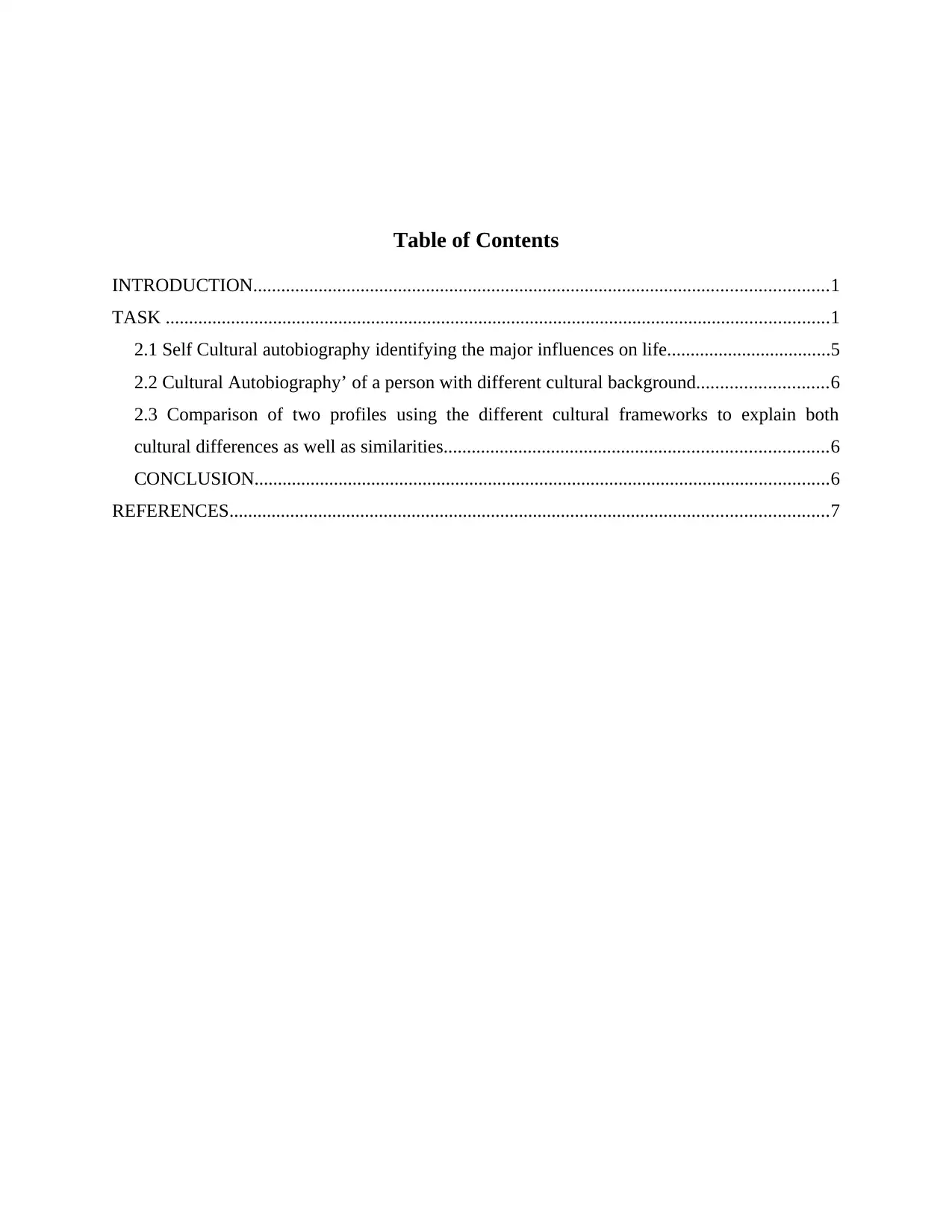
Table of Contents
INTRODUCTION...........................................................................................................................1
TASK ..............................................................................................................................................1
2.1 Self Cultural autobiography identifying the major influences on life...................................5
2.2 Cultural Autobiography’ of a person with different cultural background............................6
2.3 Comparison of two profiles using the different cultural frameworks to explain both
cultural differences as well as similarities..................................................................................6
CONCLUSION...........................................................................................................................6
REFERENCES................................................................................................................................7
INTRODUCTION...........................................................................................................................1
TASK ..............................................................................................................................................1
2.1 Self Cultural autobiography identifying the major influences on life...................................5
2.2 Cultural Autobiography’ of a person with different cultural background............................6
2.3 Comparison of two profiles using the different cultural frameworks to explain both
cultural differences as well as similarities..................................................................................6
CONCLUSION...........................................................................................................................6
REFERENCES................................................................................................................................7
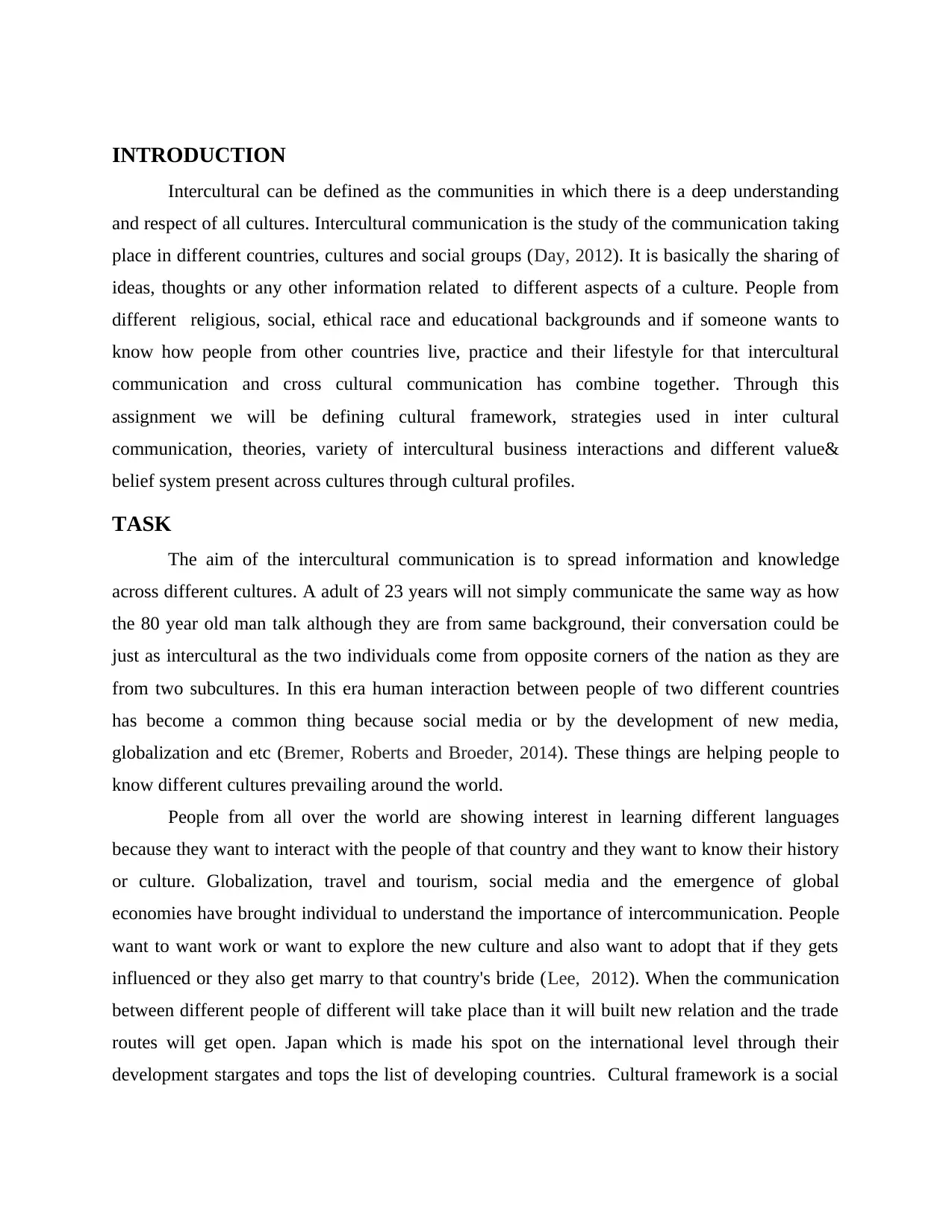
INTRODUCTION
Intercultural can be defined as the communities in which there is a deep understanding
and respect of all cultures. Intercultural communication is the study of the communication taking
place in different countries, cultures and social groups (Day, 2012). It is basically the sharing of
ideas, thoughts or any other information related to different aspects of a culture. People from
different religious, social, ethical race and educational backgrounds and if someone wants to
know how people from other countries live, practice and their lifestyle for that intercultural
communication and cross cultural communication has combine together. Through this
assignment we will be defining cultural framework, strategies used in inter cultural
communication, theories, variety of intercultural business interactions and different value&
belief system present across cultures through cultural profiles.
TASK
The aim of the intercultural communication is to spread information and knowledge
across different cultures. A adult of 23 years will not simply communicate the same way as how
the 80 year old man talk although they are from same background, their conversation could be
just as intercultural as the two individuals come from opposite corners of the nation as they are
from two subcultures. In this era human interaction between people of two different countries
has become a common thing because social media or by the development of new media,
globalization and etc (Bremer, Roberts and Broeder, 2014). These things are helping people to
know different cultures prevailing around the world.
People from all over the world are showing interest in learning different languages
because they want to interact with the people of that country and they want to know their history
or culture. Globalization, travel and tourism, social media and the emergence of global
economies have brought individual to understand the importance of intercommunication. People
want to want work or want to explore the new culture and also want to adopt that if they gets
influenced or they also get marry to that country's bride (Lee, 2012). When the communication
between different people of different will take place than it will built new relation and the trade
routes will get open. Japan which is made his spot on the international level through their
development stargates and tops the list of developing countries. Cultural framework is a social
Intercultural can be defined as the communities in which there is a deep understanding
and respect of all cultures. Intercultural communication is the study of the communication taking
place in different countries, cultures and social groups (Day, 2012). It is basically the sharing of
ideas, thoughts or any other information related to different aspects of a culture. People from
different religious, social, ethical race and educational backgrounds and if someone wants to
know how people from other countries live, practice and their lifestyle for that intercultural
communication and cross cultural communication has combine together. Through this
assignment we will be defining cultural framework, strategies used in inter cultural
communication, theories, variety of intercultural business interactions and different value&
belief system present across cultures through cultural profiles.
TASK
The aim of the intercultural communication is to spread information and knowledge
across different cultures. A adult of 23 years will not simply communicate the same way as how
the 80 year old man talk although they are from same background, their conversation could be
just as intercultural as the two individuals come from opposite corners of the nation as they are
from two subcultures. In this era human interaction between people of two different countries
has become a common thing because social media or by the development of new media,
globalization and etc (Bremer, Roberts and Broeder, 2014). These things are helping people to
know different cultures prevailing around the world.
People from all over the world are showing interest in learning different languages
because they want to interact with the people of that country and they want to know their history
or culture. Globalization, travel and tourism, social media and the emergence of global
economies have brought individual to understand the importance of intercommunication. People
want to want work or want to explore the new culture and also want to adopt that if they gets
influenced or they also get marry to that country's bride (Lee, 2012). When the communication
between different people of different will take place than it will built new relation and the trade
routes will get open. Japan which is made his spot on the international level through their
development stargates and tops the list of developing countries. Cultural framework is a social
⊘ This is a preview!⊘
Do you want full access?
Subscribe today to unlock all pages.

Trusted by 1+ million students worldwide

science term which is used to describe value system, tradition, myths and symbols that are
common in a given society.
Japanese people appears at the first glance to be one of the most socially and ethnically
homogeneous groups in the world. Citizens of Japan who lives outside the Japan are called as
Nikkeijin and Yamoto is the dominant ethnic group of Japan. People living their speaks Japonic
language and follows Mahayana and Shinto religion. Japanese literature have a influence of
Chinese literature and Indian literature (Suárez-Ortega, 2013). Japanese painters are know by the
paintings they paint and normally develop animals, landscapes on their canvas. Sculpture of
Japan mainly emphasis on Buddhist images and when we talk about their architecture we could
say that Chinese and Japanese architecture are almost same. People could see temples, Shinto
shrines and castles reflects the architecture.
Japanese traditional clothing distinguishes them from rest of the world and are called as
Kimono which is their traditional dress and worn by women, men and children on different
occasions. Generally these are the full length garment can also be refereed as naga-gi which
means “long wear”. Japanese food has unique image in the world and different people from
different countries prefer it. Noodles, Sushi, Tempura are some of the dishes which are popular
and symbolizes Japanese food. Their culture reflects the history of Japan whether its like
television programs, music, video games, movies all show are linked with the history of Japan.
Their are key aspects of intercultural communication like perception, beliefs, values,
culture and pragmatics and interactional norms. Perception is a internal process in whi9ch we
organise and intercept information from outside world. Whatever image we have of Japan in our
mind we will feel and see through that only which is the perception of individual for a particular
thing (Peiser and Jones, 2014). So the two person cannot have same perception on a single place
as everyone has its own way of interpreting things. Perception is made through our experience
for example although I might have not visiting Japan in my all life but still I have a image of
Japan in mind as I have seen things in TV. Perception affects the view point of the individual and
group because everybody everyone has different view point for different thing and it also
influence how we communicate with each other.
Beliefs which is the next aspect of intercultural communication is about the judgement
we make about the different things like what is wrong and what is right. A tourist visiting Japan
common in a given society.
Japanese people appears at the first glance to be one of the most socially and ethnically
homogeneous groups in the world. Citizens of Japan who lives outside the Japan are called as
Nikkeijin and Yamoto is the dominant ethnic group of Japan. People living their speaks Japonic
language and follows Mahayana and Shinto religion. Japanese literature have a influence of
Chinese literature and Indian literature (Suárez-Ortega, 2013). Japanese painters are know by the
paintings they paint and normally develop animals, landscapes on their canvas. Sculpture of
Japan mainly emphasis on Buddhist images and when we talk about their architecture we could
say that Chinese and Japanese architecture are almost same. People could see temples, Shinto
shrines and castles reflects the architecture.
Japanese traditional clothing distinguishes them from rest of the world and are called as
Kimono which is their traditional dress and worn by women, men and children on different
occasions. Generally these are the full length garment can also be refereed as naga-gi which
means “long wear”. Japanese food has unique image in the world and different people from
different countries prefer it. Noodles, Sushi, Tempura are some of the dishes which are popular
and symbolizes Japanese food. Their culture reflects the history of Japan whether its like
television programs, music, video games, movies all show are linked with the history of Japan.
Their are key aspects of intercultural communication like perception, beliefs, values,
culture and pragmatics and interactional norms. Perception is a internal process in whi9ch we
organise and intercept information from outside world. Whatever image we have of Japan in our
mind we will feel and see through that only which is the perception of individual for a particular
thing (Peiser and Jones, 2014). So the two person cannot have same perception on a single place
as everyone has its own way of interpreting things. Perception is made through our experience
for example although I might have not visiting Japan in my all life but still I have a image of
Japan in mind as I have seen things in TV. Perception affects the view point of the individual and
group because everybody everyone has different view point for different thing and it also
influence how we communicate with each other.
Beliefs which is the next aspect of intercultural communication is about the judgement
we make about the different things like what is wrong and what is right. A tourist visiting Japan
Paraphrase This Document
Need a fresh take? Get an instant paraphrase of this document with our AI Paraphraser

will have its beliefs on the basis of objects and events. For example; Japanese people have their
belief in the Buddhism so they follow that religion. We have a explanation for things we believe
in and some of the beliefs are unpredictable and cannot be answered. Cross cultural business
communication can be built through coaching and training in cross cultural communication in a
business communication (Barea and et. al., 2010). There are different types of theories which
helps us to understand intercultural communication, some of the theories are as follows:-
Convergence model of communication:- This theory says that two people participate in a
dialogue and exchange ideas and information so that they could reach a level of mutual
understanding. Cultural convergence also state that due to culture differences communication
sometimes become difficult and this act as barrier of communication.
Identity Management Theory says that interpersonal competence is ability of to negotiate
mutually the acceptable identities of interaction.
There are different cultures, values, prevail in different parts of world and Japan is one of them.
Culture is something which include educational, national, religious, spiritual, family, gender,
generational, sexual orientation and all these factors affects our life in some or other way. We
describe and look distinguish different nations based on these factors and we learn these cultures
as we spend our life on different locations and areas. It can be seen that a individual culture can
be powerful and can take over other culture depending upon what are the situation. For example;
religious culture may dominate over sexual culture and national culture dominates over religious
culture. For example; In a country where lots of religion exists and people differentiate
themselves on basis of this religion but a time comes when the national pride or culture becomes
more important than their religion identity (Holliday, 2012).
There are lots of ways in which culture influences us or we can say that there are some
aspects of culture impacts our day to day life like what we do, how we work, how we interact
with people, what is our behaviour, our use of language, how we deal with the problems and
solve it and how we create relationship with others.
We will prepare a Culture profile of Japan to know it better:-
belief in the Buddhism so they follow that religion. We have a explanation for things we believe
in and some of the beliefs are unpredictable and cannot be answered. Cross cultural business
communication can be built through coaching and training in cross cultural communication in a
business communication (Barea and et. al., 2010). There are different types of theories which
helps us to understand intercultural communication, some of the theories are as follows:-
Convergence model of communication:- This theory says that two people participate in a
dialogue and exchange ideas and information so that they could reach a level of mutual
understanding. Cultural convergence also state that due to culture differences communication
sometimes become difficult and this act as barrier of communication.
Identity Management Theory says that interpersonal competence is ability of to negotiate
mutually the acceptable identities of interaction.
There are different cultures, values, prevail in different parts of world and Japan is one of them.
Culture is something which include educational, national, religious, spiritual, family, gender,
generational, sexual orientation and all these factors affects our life in some or other way. We
describe and look distinguish different nations based on these factors and we learn these cultures
as we spend our life on different locations and areas. It can be seen that a individual culture can
be powerful and can take over other culture depending upon what are the situation. For example;
religious culture may dominate over sexual culture and national culture dominates over religious
culture. For example; In a country where lots of religion exists and people differentiate
themselves on basis of this religion but a time comes when the national pride or culture becomes
more important than their religion identity (Holliday, 2012).
There are lots of ways in which culture influences us or we can say that there are some
aspects of culture impacts our day to day life like what we do, how we work, how we interact
with people, what is our behaviour, our use of language, how we deal with the problems and
solve it and how we create relationship with others.
We will prepare a Culture profile of Japan to know it better:-
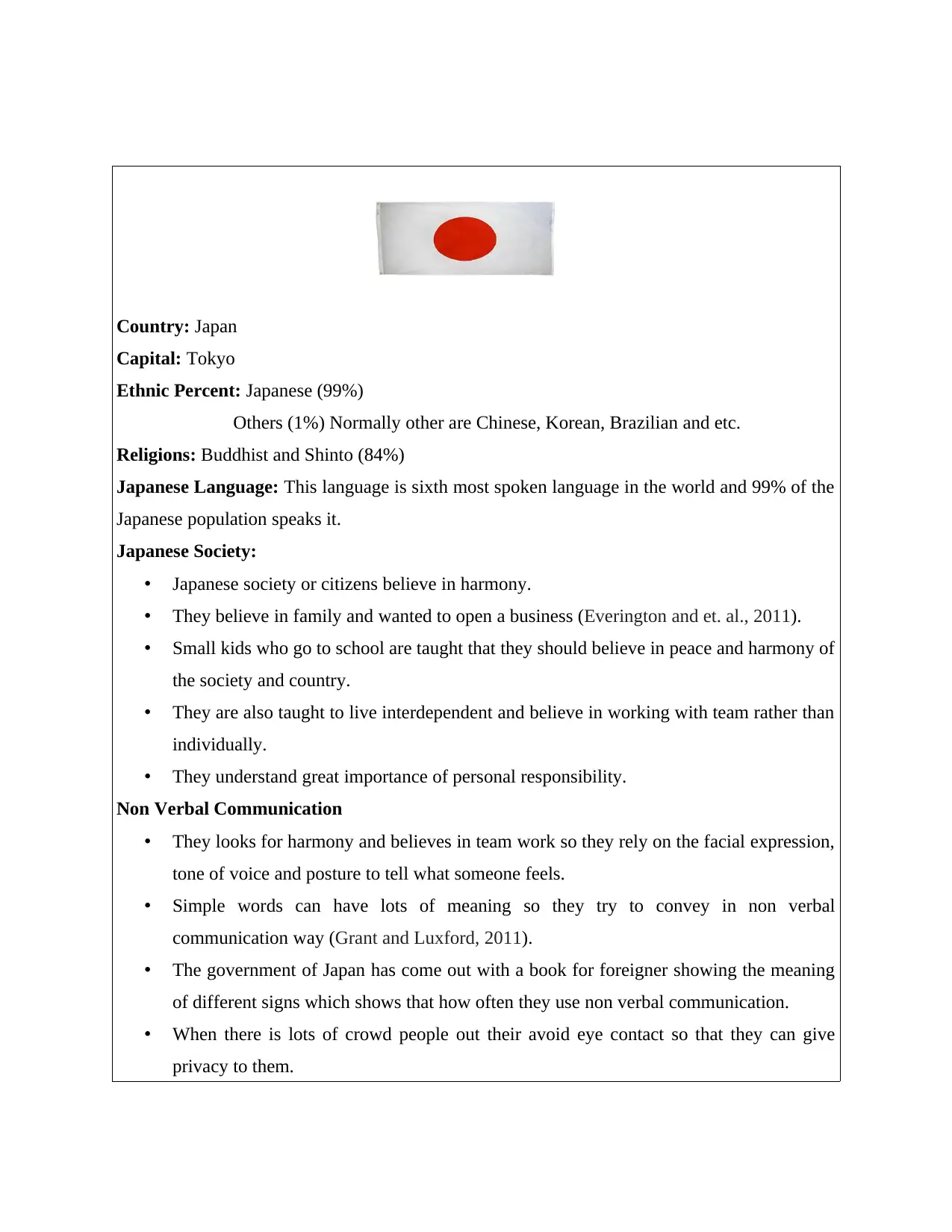
Country: Japan
Capital: Tokyo
Ethnic Percent: Japanese (99%)
Others (1%) Normally other are Chinese, Korean, Brazilian and etc.
Religions: Buddhist and Shinto (84%)
Japanese Language: This language is sixth most spoken language in the world and 99% of the
Japanese population speaks it.
Japanese Society:
• Japanese society or citizens believe in harmony.
• They believe in family and wanted to open a business (Everington and et. al., 2011).
• Small kids who go to school are taught that they should believe in peace and harmony of
the society and country.
• They are also taught to live interdependent and believe in working with team rather than
individually.
• They understand great importance of personal responsibility.
Non Verbal Communication
• They looks for harmony and believes in team work so they rely on the facial expression,
tone of voice and posture to tell what someone feels.
• Simple words can have lots of meaning so they try to convey in non verbal
communication way (Grant and Luxford, 2011).
• The government of Japan has come out with a book for foreigner showing the meaning
of different signs which shows that how often they use non verbal communication.
• When there is lots of crowd people out their avoid eye contact so that they can give
privacy to them.
Capital: Tokyo
Ethnic Percent: Japanese (99%)
Others (1%) Normally other are Chinese, Korean, Brazilian and etc.
Religions: Buddhist and Shinto (84%)
Japanese Language: This language is sixth most spoken language in the world and 99% of the
Japanese population speaks it.
Japanese Society:
• Japanese society or citizens believe in harmony.
• They believe in family and wanted to open a business (Everington and et. al., 2011).
• Small kids who go to school are taught that they should believe in peace and harmony of
the society and country.
• They are also taught to live interdependent and believe in working with team rather than
individually.
• They understand great importance of personal responsibility.
Non Verbal Communication
• They looks for harmony and believes in team work so they rely on the facial expression,
tone of voice and posture to tell what someone feels.
• Simple words can have lots of meaning so they try to convey in non verbal
communication way (Grant and Luxford, 2011).
• The government of Japan has come out with a book for foreigner showing the meaning
of different signs which shows that how often they use non verbal communication.
• When there is lots of crowd people out their avoid eye contact so that they can give
privacy to them.
⊘ This is a preview!⊘
Do you want full access?
Subscribe today to unlock all pages.

Trusted by 1+ million students worldwide
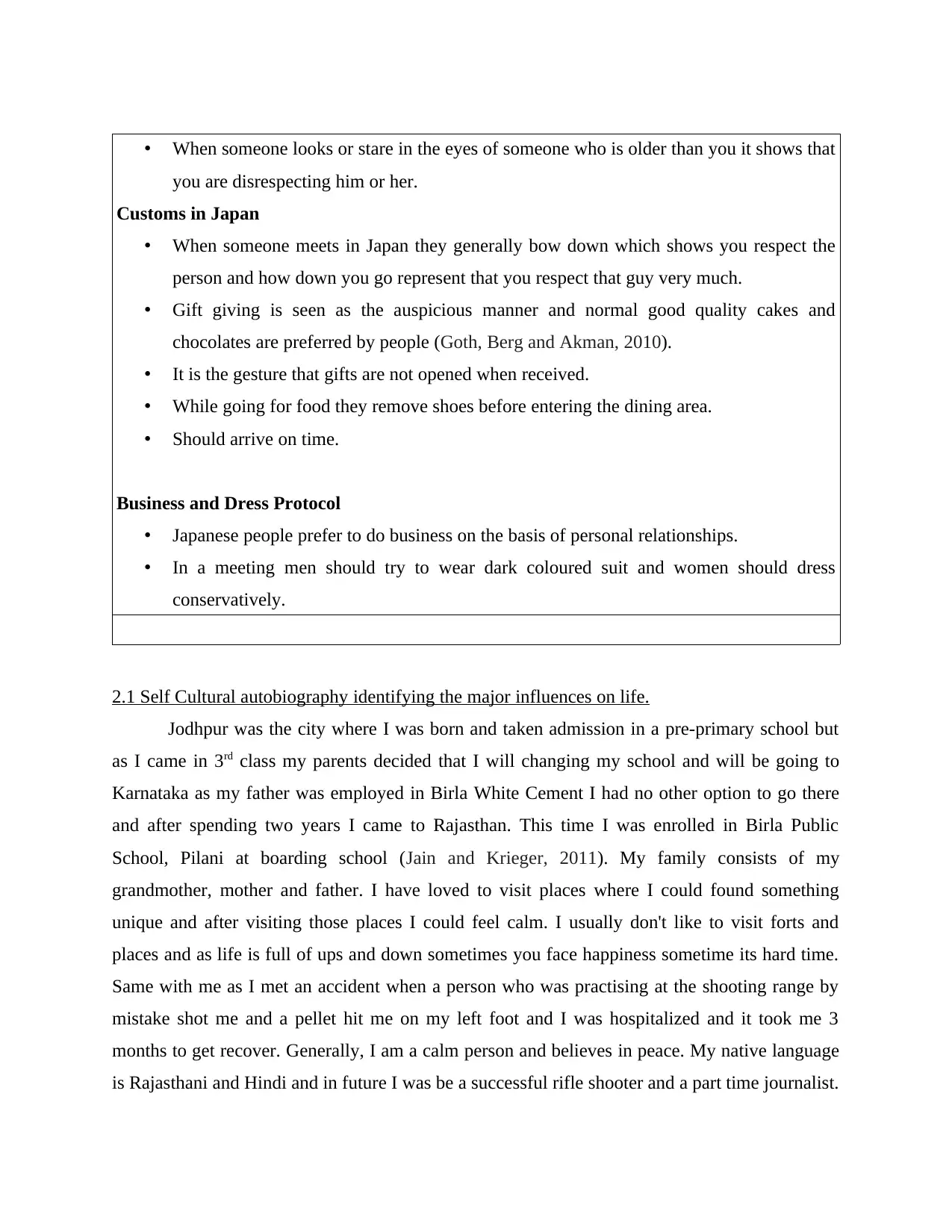
• When someone looks or stare in the eyes of someone who is older than you it shows that
you are disrespecting him or her.
Customs in Japan
• When someone meets in Japan they generally bow down which shows you respect the
person and how down you go represent that you respect that guy very much.
• Gift giving is seen as the auspicious manner and normal good quality cakes and
chocolates are preferred by people (Goth, Berg and Akman, 2010).
• It is the gesture that gifts are not opened when received.
• While going for food they remove shoes before entering the dining area.
• Should arrive on time.
Business and Dress Protocol
• Japanese people prefer to do business on the basis of personal relationships.
• In a meeting men should try to wear dark coloured suit and women should dress
conservatively.
2.1 Self Cultural autobiography identifying the major influences on life.
Jodhpur was the city where I was born and taken admission in a pre-primary school but
as I came in 3rd class my parents decided that I will changing my school and will be going to
Karnataka as my father was employed in Birla White Cement I had no other option to go there
and after spending two years I came to Rajasthan. This time I was enrolled in Birla Public
School, Pilani at boarding school (Jain and Krieger, 2011). My family consists of my
grandmother, mother and father. I have loved to visit places where I could found something
unique and after visiting those places I could feel calm. I usually don't like to visit forts and
places and as life is full of ups and down sometimes you face happiness sometime its hard time.
Same with me as I met an accident when a person who was practising at the shooting range by
mistake shot me and a pellet hit me on my left foot and I was hospitalized and it took me 3
months to get recover. Generally, I am a calm person and believes in peace. My native language
is Rajasthani and Hindi and in future I was be a successful rifle shooter and a part time journalist.
you are disrespecting him or her.
Customs in Japan
• When someone meets in Japan they generally bow down which shows you respect the
person and how down you go represent that you respect that guy very much.
• Gift giving is seen as the auspicious manner and normal good quality cakes and
chocolates are preferred by people (Goth, Berg and Akman, 2010).
• It is the gesture that gifts are not opened when received.
• While going for food they remove shoes before entering the dining area.
• Should arrive on time.
Business and Dress Protocol
• Japanese people prefer to do business on the basis of personal relationships.
• In a meeting men should try to wear dark coloured suit and women should dress
conservatively.
2.1 Self Cultural autobiography identifying the major influences on life.
Jodhpur was the city where I was born and taken admission in a pre-primary school but
as I came in 3rd class my parents decided that I will changing my school and will be going to
Karnataka as my father was employed in Birla White Cement I had no other option to go there
and after spending two years I came to Rajasthan. This time I was enrolled in Birla Public
School, Pilani at boarding school (Jain and Krieger, 2011). My family consists of my
grandmother, mother and father. I have loved to visit places where I could found something
unique and after visiting those places I could feel calm. I usually don't like to visit forts and
places and as life is full of ups and down sometimes you face happiness sometime its hard time.
Same with me as I met an accident when a person who was practising at the shooting range by
mistake shot me and a pellet hit me on my left foot and I was hospitalized and it took me 3
months to get recover. Generally, I am a calm person and believes in peace. My native language
is Rajasthani and Hindi and in future I was be a successful rifle shooter and a part time journalist.
Paraphrase This Document
Need a fresh take? Get an instant paraphrase of this document with our AI Paraphraser
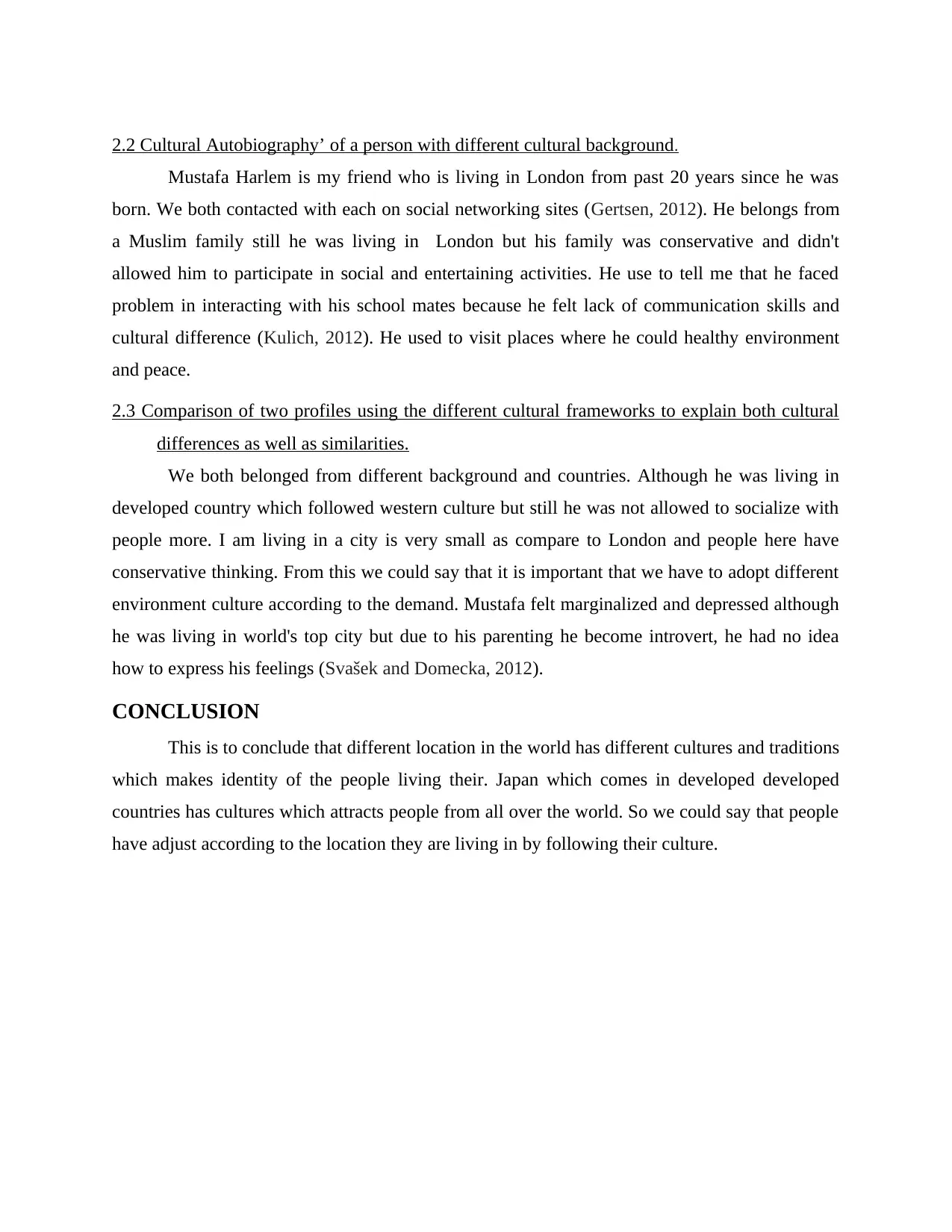
2.2 Cultural Autobiography’ of a person with different cultural background.
Mustafa Harlem is my friend who is living in London from past 20 years since he was
born. We both contacted with each on social networking sites (Gertsen, 2012). He belongs from
a Muslim family still he was living in London but his family was conservative and didn't
allowed him to participate in social and entertaining activities. He use to tell me that he faced
problem in interacting with his school mates because he felt lack of communication skills and
cultural difference (Kulich, 2012). He used to visit places where he could healthy environment
and peace.
2.3 Comparison of two profiles using the different cultural frameworks to explain both cultural
differences as well as similarities.
We both belonged from different background and countries. Although he was living in
developed country which followed western culture but still he was not allowed to socialize with
people more. I am living in a city is very small as compare to London and people here have
conservative thinking. From this we could say that it is important that we have to adopt different
environment culture according to the demand. Mustafa felt marginalized and depressed although
he was living in world's top city but due to his parenting he become introvert, he had no idea
how to express his feelings (Svašek and Domecka, 2012).
CONCLUSION
This is to conclude that different location in the world has different cultures and traditions
which makes identity of the people living their. Japan which comes in developed developed
countries has cultures which attracts people from all over the world. So we could say that people
have adjust according to the location they are living in by following their culture.
Mustafa Harlem is my friend who is living in London from past 20 years since he was
born. We both contacted with each on social networking sites (Gertsen, 2012). He belongs from
a Muslim family still he was living in London but his family was conservative and didn't
allowed him to participate in social and entertaining activities. He use to tell me that he faced
problem in interacting with his school mates because he felt lack of communication skills and
cultural difference (Kulich, 2012). He used to visit places where he could healthy environment
and peace.
2.3 Comparison of two profiles using the different cultural frameworks to explain both cultural
differences as well as similarities.
We both belonged from different background and countries. Although he was living in
developed country which followed western culture but still he was not allowed to socialize with
people more. I am living in a city is very small as compare to London and people here have
conservative thinking. From this we could say that it is important that we have to adopt different
environment culture according to the demand. Mustafa felt marginalized and depressed although
he was living in world's top city but due to his parenting he become introvert, he had no idea
how to express his feelings (Svašek and Domecka, 2012).
CONCLUSION
This is to conclude that different location in the world has different cultures and traditions
which makes identity of the people living their. Japan which comes in developed developed
countries has cultures which attracts people from all over the world. So we could say that people
have adjust according to the location they are living in by following their culture.

REFERENCES
Books and Journals
Day, G., 2012. The evolution of European identities: Biographical approaches. Palgrave
Macmillan.
Bremer, K., Roberts, C and Broeder, P., 2014. Achieving understanding: Discourse in
intercultural encounters. Routledge.
Lee, L., 2012. Engaging study abroad students in intercultural learning through blogging and
ethnographic interviews. Foreign Language Annals. 45(1). pp.7-21.
Suárez-Ortega, M., 2013. Performance, reflexivity, and learning through biographical-narrative
research. Qualitative Inquiry. 19(3). pp.189-200.
Peiser, G and Jones, M., 2014. The influence of teachers’ interests, personalities and life
experiences in intercultural languages teaching. Teachers and Teaching. 20(3). pp.375-
390.
Barea and et. al., 2010. Transmigrant families: Intercultural and bilingual competences
development. Globalisation, Societies and Education. 8(3). pp.429-442.
Holliday, A., 2012. Interrogating researcher participation in an interview study of intercultural
contribution in the workplace. Qualitative Inquiry. 18(6). pp.504-515.
Everington and et., 2011. European religious education teachers' perceptions of and responses to
classroom diversity and their relationship to personal and professional
biographies. British Journal of Religious Education. 33(2). pp.241-256.
Goth, U., Berg, J and Akman, H., 2010. The intercultural challenges of general practitioners in
Norway with migrant patients. International Journal of Migration, Health and Social
Care. 6(1). pp.26-33.
Jain, P and Krieger, J.L., 2011. Moving beyond the language barrier: The communication
strategies used by international medical graduates in intercultural medical
encounters. Patient education and counseling. 84(1). pp.98-104.
Gertsen, M.C., 2012. Learning from difference: Born Global SMEs and their approaches to
intercultural collaboration in Asia. Global collaboration: Intercultural experiences and
learning. p.207.
Kulich, S.J., 2012. Reconstucting the histories and influences of 1970s intercultural leaders:
Prelude to biographies. International Journal of Intercultural Relations. 36(6). pp.744-
759.
Svašek, M and Domecka, M., 2012. The autobiographical narrative interview. A potential arena
of emotional remembering, performance and reflection. The interview: An ethnographic
approach. pp.107-126.
Grant, J and Luxford, Y., 2011. ‘Culture it’sa big term isn’t it’? An analysis of child and family
health nurses’ understandings of culture and intercultural communication. Health
sociology review. 20(1). pp.16-27.
Martínez, D.O., 2013. Intellectual biography, empirical sociology and normative political theory:
An interview with Tariq Modood. Journal of Intercultural Studies. 34(6). pp.729-741.
Online
Books and Journals
Day, G., 2012. The evolution of European identities: Biographical approaches. Palgrave
Macmillan.
Bremer, K., Roberts, C and Broeder, P., 2014. Achieving understanding: Discourse in
intercultural encounters. Routledge.
Lee, L., 2012. Engaging study abroad students in intercultural learning through blogging and
ethnographic interviews. Foreign Language Annals. 45(1). pp.7-21.
Suárez-Ortega, M., 2013. Performance, reflexivity, and learning through biographical-narrative
research. Qualitative Inquiry. 19(3). pp.189-200.
Peiser, G and Jones, M., 2014. The influence of teachers’ interests, personalities and life
experiences in intercultural languages teaching. Teachers and Teaching. 20(3). pp.375-
390.
Barea and et. al., 2010. Transmigrant families: Intercultural and bilingual competences
development. Globalisation, Societies and Education. 8(3). pp.429-442.
Holliday, A., 2012. Interrogating researcher participation in an interview study of intercultural
contribution in the workplace. Qualitative Inquiry. 18(6). pp.504-515.
Everington and et., 2011. European religious education teachers' perceptions of and responses to
classroom diversity and their relationship to personal and professional
biographies. British Journal of Religious Education. 33(2). pp.241-256.
Goth, U., Berg, J and Akman, H., 2010. The intercultural challenges of general practitioners in
Norway with migrant patients. International Journal of Migration, Health and Social
Care. 6(1). pp.26-33.
Jain, P and Krieger, J.L., 2011. Moving beyond the language barrier: The communication
strategies used by international medical graduates in intercultural medical
encounters. Patient education and counseling. 84(1). pp.98-104.
Gertsen, M.C., 2012. Learning from difference: Born Global SMEs and their approaches to
intercultural collaboration in Asia. Global collaboration: Intercultural experiences and
learning. p.207.
Kulich, S.J., 2012. Reconstucting the histories and influences of 1970s intercultural leaders:
Prelude to biographies. International Journal of Intercultural Relations. 36(6). pp.744-
759.
Svašek, M and Domecka, M., 2012. The autobiographical narrative interview. A potential arena
of emotional remembering, performance and reflection. The interview: An ethnographic
approach. pp.107-126.
Grant, J and Luxford, Y., 2011. ‘Culture it’sa big term isn’t it’? An analysis of child and family
health nurses’ understandings of culture and intercultural communication. Health
sociology review. 20(1). pp.16-27.
Martínez, D.O., 2013. Intellectual biography, empirical sociology and normative political theory:
An interview with Tariq Modood. Journal of Intercultural Studies. 34(6). pp.729-741.
Online
⊘ This is a preview!⊘
Do you want full access?
Subscribe today to unlock all pages.

Trusted by 1+ million students worldwide

What’s Your Cultural Profile?. 2017. [Online]. Available through
<https://hbr.org/web/assessment/2014/08/whats-your-cultural-profile>. [Accessed on 7th
June 2017].
<https://hbr.org/web/assessment/2014/08/whats-your-cultural-profile>. [Accessed on 7th
June 2017].
1 out of 10
Related Documents
Your All-in-One AI-Powered Toolkit for Academic Success.
+13062052269
info@desklib.com
Available 24*7 on WhatsApp / Email
![[object Object]](/_next/static/media/star-bottom.7253800d.svg)
Unlock your academic potential
Copyright © 2020–2025 A2Z Services. All Rights Reserved. Developed and managed by ZUCOL.



